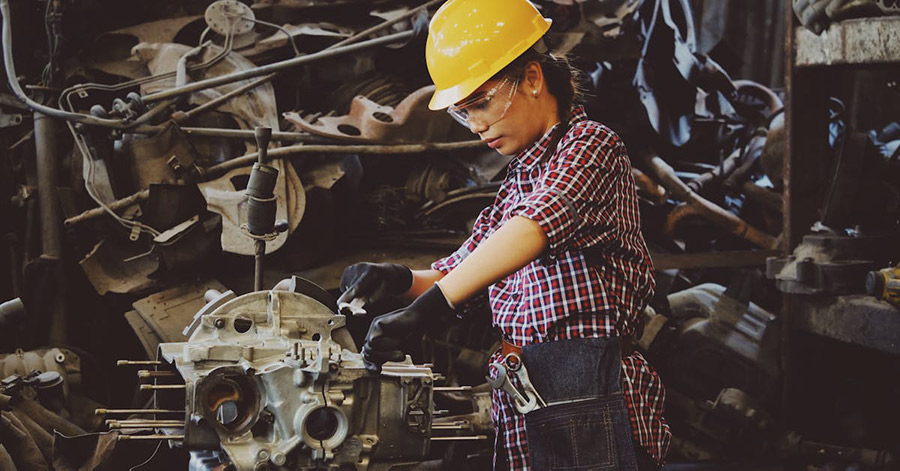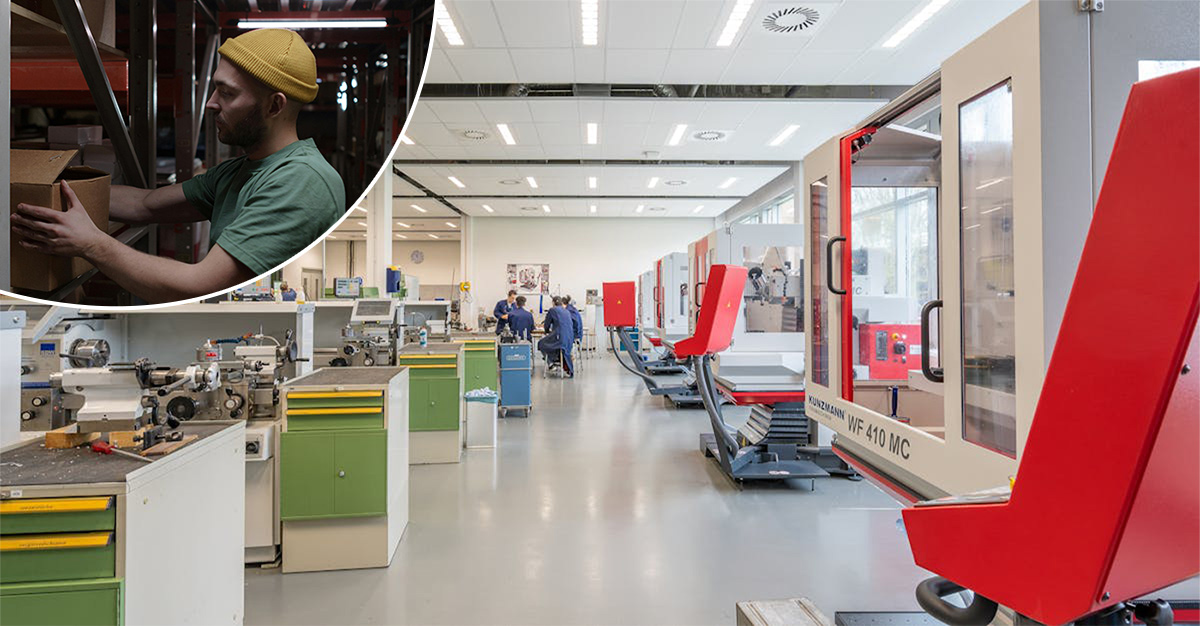Industrial emergency lighting is a specialized lighting system designed to provide illumination during power outages or emergency situations in industrial settings. It plays a crucial role in ensuring workplace safety by guiding employees to safety exits and secure areas during critical situations. These systems typically consist of emergency light fixtures equipped with backup power sources, such as batteries or generators, and are strategically placed throughout the facility to ensure adequate visibility during emergencies.

Industrial emergency lighting – How does it work?
In industrial settings, where the stakes are high and the potential for emergencies is ever-present, industrial emergency lighting stands as a beacon of safety. Its primary purpose is to maintain visibility to key areas and prevent panic during critical situations. These systems are essential for guiding employees to safety exits or other secure areas in the event of an emergency. They minimize the risk of accidents, injuries, and loss of life. But what exactly is industrial emergency lighting and how does it work? Let’s delve deeper into this:
Integral components
The functionality of emergency lighting systems relies on a carefully orchestrated assembly of components. Let’s explore the integral elements that make up these systems:
Emergency light fixtures
At the forefront of industrial emergency lighting systems are the emergency light fixtures themselves. These fixtures serve as the frontline sources of illumination during power outages or other emergencies. Positioned strategically throughout the facility, they ensure visibility in critical areas where safety is paramount.
Backup power sources
The reliability of emergency lighting systems hinges on their ability to remain operational even when faced with power disruptions. To achieve this resilience, emergency light fixtures are equipped with backup power sources. Among the most common options for backup power are batteries and generators.
Battery-powered emergency light fixtures rely on stored electrical energy to provide illumination during emergencies. These batteries are typically rechargeable and capable of sustaining light output for extended periods, ensuring continuous visibility until power is restored. In facilities where prolonged power outages are a concern, generators serve as robust backup power sources for emergency lighting systems. Powered by fuel or other energy sources, generators can sustain illumination for extended durations, offering a reliable solution for maintaining visibility during emergencies.
Control systems and monitoring devices
To ensure seamless operation and optimal performance, industrial emergency lighting systems often incorporate sophisticated control systems and monitoring devices. These components enable facility managers to automate activation.
Control systems can be programmed to automatically activate emergency lighting in response to power outages or other predefined triggers, ensuring timely illumination without the need for manual intervention. Monitoring devices provide real-time feedback on the status and performance of emergency lighting systems. By monitoring factors such as battery levels, light output, and system integrity, facility managers can proactively address any issues that may compromise system functionality.
Wiring and connectivity infrastructure
The efficacy of emergency lighting systems relies heavily on robust wiring and connectivity infrastructure. Proper wiring ensures the seamless transmission of power from backup sources to emergency light fixtures, while connectivity infrastructure facilitates communication between control systems, monitoring devices, and other system components. To mitigate the risk of single points of failure, emergency lighting systems often incorporate redundant wiring configurations. Redundant wiring paths ensure continuity of power delivery, even in the event of wiring faults or disruptions.
Integrating IoT LED technology
As part of the integral components of industrial emergency lighting systems, the latest advancements include the integration of IoT LED technology. These systems utilize IoT-enabled LED fixtures to provide efficient and reliable illumination during emergencies. The combination of IoT capabilities and LED lighting enhances system functionality and ensures seamless operation.
More information here: www.en.wikipedia.org/wiki/Emergency_light
Strategic placement of industrial emergency lighting
Industrial emergency lighting systems rely on strategic placement to ensure comprehensive coverage and enhance workplace safety. Let’s explore the most important areas:
Illuminating exit routes
Exit routes serve as crucial pathways for personnel to evacuate safely during emergencies. Emergency light fixtures strategically installed along these routes illuminate clear pathways, guiding individuals to exits even in the absence of primary lighting. By ensuring visibility along exit routes, these fixtures mitigate confusion and enable efficient egress, ultimately safeguarding lives.
Lighting up stairwells
Stairwells pose unique challenges during evacuations, especially in multi-story facilities. Proper illumination in stairwells is essential for facilitating safe navigation between different levels of the facility, particularly when elevators are unavailable or unsuitable for use. Emergency light fixtures strategically placed in stairwells illuminate each step and landing, reducing the risk of trips and falls and facilitating a smooth descent or ascent during evacuations.
Brightening designated assembly points
Designated assembly points serve as gathering locations where personnel congregate following evacuations, allowing for accountability and coordination of post-evacuation procedures. These areas must be well-lit to ensure visibility and facilitate efficient communication and headcounts. Emergency light fixtures strategically positioned in assembly points create beacon-like zones, drawing individuals together and enhancing overall visibility for emergency response coordination.

Ensuring compliance and reliability
Compliance with regulations and standards is paramount in industrial settings. Industrial emergency lighting systems must adhere to industry-specific regulations and standards to ensure reliability and effectiveness and tp minimize risks
Regulatory adherence
Industrial emergency lighting systems are subject to a myriad of regulations and standards established by governing bodies and industry organizations. These regulations outline specific requirements for emergency lighting design, installation, and operation to ensure the safety of personnel and property in industrial environments. Industrial facilities must comply with these regulations to mitigate potential hazards and ensure workplace safety during emergencies.
Industry-specific standards
In addition to regulatory requirements, industrial emergency lighting systems must also adhere to industry-specific standards and guidelines. These standards are developed by industry organizations and associations to address unique challenges and considerations within industrial environments. By following industry-specific standards, emergency lighting systems can meet the specific needs and requirements of industrial facilities while ensuring reliability and effectiveness in emergency situations.
Regular testing and maintenance
To maintain compliance and reliability, regular testing and maintenance of industrial emergency lighting systems are essential. Facility managers must conduct periodic inspections and tests to verify the functionality of the system and identify any potential issues or deficiencies. Routine maintenance activities, such as cleaning, lamp replacement, and battery checks, help ensure that emergency lighting systems remain in optimal working condition and ready to perform when needed.
Prompt issue resolution
In the event of any issues or failures, prompt resolution is crucial to maintaining compliance and reliability. Facility managers must promptly address any identified issues or deficiencies through corrective actions, such as repairs or replacements. By addressing issues promptly, facility managers can ensure the continued functionality and effectiveness of industrial emergency lighting systems, minimizing downtime and potential safety risks.
In the event of chemical exposure: www.nordicinformer.com/emergency-eye-wash-station-instructions/
Potential consequences of not having industrial emergency lighting
Failure to implement industrial emergency lighting can have serious consequences in the event of an emergency. Without adequate illumination, employees may struggle to navigate darkened areas, increasing the risk of trips, falls, and other accidents. In extreme cases, the lack of emergency lighting can impede evacuation efforts, leading to potential injuries or loss of life.

Other measures for workplace security
In industrial settings, ensuring safety encompasses a multifaceted approach beyond individual components like emergency lighting. It involves considering adjacent subjects and measures that can improve overall workplace safety. Here’s an overview of such topics, including (but not limited to) the importance of door stops and other related safety measures:
Fire safety
Fire prevention and protection are essential in industrial safety. This includes using fire-resistant materials, installing fire alarms and sprinkler systems, and providing training to personnel in firefighting and evacuation techniques. Having effective fire safety measures in place can minimize the risk of fires and reduce the damage in case of a fire outbreak.
Door stops
Door stops are important safety measures that prevent doors from colliding with people or equipment, potentially causing injuries. By using sturdy and reliable door stops, the risk of accidents can be minimized, ensuring safe passage through doorways in the workplace. Additionally, it’s important to have secure and well-maintained doors to prevent unauthorized access and protect personnel and assets from external threats or hazards.
Read more here: www.dictator.se/dorrstopp-ytterdorr/
Workplace environment
Creating a safe and ergonomic workplace environment is also important in reducing the risk of work-related injuries and illnesses. This includes designing workstations and equipment to minimize physical strain and creating an ergonomically favorable working environment for employees. By investing in ergonomic solutions, companies can improve work performance and employee well-being while reducing the risk of injuries and illnesses.
Personal protective Eeuipment (PPE)
The use of personal protective equipment is crucial for protecting personnel against potential hazards and risks in the workplace. This includes safety helmets, eye protection, ear protection, respiratory protection, and protective clothing. Providing the right PPE and training employees in its correct use and maintenance are important to ensure their safety and well-being.
Material handling
Proper handling of hazardous materials is crucial to industrial safety. This includes storing, transporting, and disposing of hazardous substances in compliance with regulations and safety protocols. Employees should be trained in the safe handling procedures for hazardous materials, including the use of personal protective equipment and emergency response protocols. By implementing strict guidelines and procedures for handling hazardous materials, the risk of accidents, spills, and exposure can be significantly reduced, ensuring a safer working environment for all personnel.
Machinery safety
Ensuring the safety of machinery is essential in industrial environments where heavy equipment and machinery are commonly used. This involves regular inspection, maintenance, and proper guarding of machinery to prevent accidents and injuries. Employees should receive thorough training on operating machinery safely, including understanding safety features, emergency shutdown procedures, and proper use of protective guards. By prioritizing machinery safety measures, companies can mitigate the risk of workplace accidents and create a safer working environment for employees.
More on this topic: www.iotled.net/industrial-plant-design/


